Scottish Crime and Justice Survey 2014/15: Partner Abuse
Results from the Partner Abuse module of the 2014/15 Scottish Crime and Justice Survey.
3. The Nature and Impact of Partner Abuse
3.1 Summary of findings
Types of partner abuse
Victims experienced a range of abusive behaviours, both psychological and physical. Victims experienced psychological abuse more commonly than physical abuse.
- On average, those who experienced partner abuse since the age of 16 reported around two different types of physical abuse, and around three different types of psychological abuse.
- The most common types of psychological abuse among victims of partner abuse (since age 16) were having a partner behaving in a jealous or controlling way (7.6%), and being repeatedly put down by a partner (6.3%).
- Among partner abuse victims since the age of 16, some types of psychological abuse were experienced by a higher proportion of women than men. For example, 59.0% of women experienced a partner behave in a jealous or controlling way, compared to 42.4% of men, whilst 53.7% of women were repeatedly put down by their partner, compared to 25.9% of men.
- The most common types of physical abuse (since age 16) were being kicked or bitten (5.2%), being pushed or held down (5.0%), and having something thrown at you, with the intention of causing harm (4.7%).
- Among partner abuse victims since the age of 16, women were more likely than men to experience physical abuse involving direct contact. For example, being pushed or held down (45.3% women, compared to 14.2% men); being choked, strangled or smothered (22.7% women, compared to 6.6% men) and forced intercourse (20.1% women, compared to 1.9% men).
- Men were more likely than women to experience non-contact violence, specifically having something thrown at them at 40.1% and 30.7% respectively.
Relationships and children
For some victims, the impact of partner abuse extended to the wider family:
- Around a third (33.5%) of those who had experienced partner abuse in the last 12 months were living with the abusive partner at the time of the most recent incident. Just under half (48.3%) of these respondents said that they were still living with the abusive partner at the time of survey interview.
- Two in five (39.4%) of those who experienced partner abuse in the last 12 months said that children were living in their household when the most recent incident took place.
- Where children were in the household, nearly two thirds (63.7%) said that the children were present (in, or around the house or close by) during the most recent incident.
Impact of partner of abuse
The impact of partner abuse was wide-ranging. Overall, psychological effects were reported more commonly than physical effects. However, not all respondents who experienced partner abuse considered themselves to be a victim. Respondents were more likely to view physical abuse as a crime, compared to psychological abuse. Of those who experienced partner abuse in the last 12 months:
- Two-thirds (65.2%) reported at least one psychological effect, and 39.6% reported at least one physical effect.
- The most common psychological effect was low self-esteem, reported by 37.4% of victims. A higher proportion of women than men experienced low self-esteem, at 44.5%, and 27.2% respectively.
- Two in five (40.5%) reported two or more psychological effects, whilst one in five (21.9%) reported four or more effects.
- A higher proportion of women than men experienced four or more psychological effects, at 31.1% and 8.8%, respectively.
- The most common physical impacts were; minor bruising or black eyes (21.6%); scratches or minor cuts (15.2%); and severe bruising (8.5%).
Perceptions of partner abuse
- Around a third (32.5%) viewed their experiences of physical abuse (in the last 12 months) as a crime, compared to 17.9% who viewed their experiences of psychological abuse as a crime.
- Just under half (46.3%) of those who had experienced at least one incident of psychological or physical partner abuse since age 16 considered themselves to be a victim of domestic abuse. This proportion was higher amongst women at 56.9%, compared to men at 22.9%.
- While 7.9% of respondents considered themselves to have been a victim of domestic abuse since age 16, this was lower than the proportion that reported incidents of partner abuse in the same period (14.1%).
3.2 Introduction
This chapter examines different types of partner abuse experienced by victims, victim-offender relationships and the presence of children, the impact of abuse, and victim perceptions of partner abuse.
3.3 Types of partner abuse
Respondent were asked if they have experienced a range of abusive behaviours, both psychological and physical. As reported in Section 2.2, 12.2% of respondents had experienced at least one incident of psychological abuse since the age of 16, and 9.6% had experienced at least one incident of physical abuse.
This section of the report examines different types of abuse amongst those who had reported at least one incident of partner abuse since age 16 ( n = 1,427) in more detail. The findings show that victimization was likely to involve multiple types of abuse.
3.3.1 Psychological abuse
Looking only at those who had experienced partner abuse since the age of 16, on average, victims had experienced three different types of psychological abuse. A higher proportion of women than men had experienced eight different types of psychological abuse.
In four categories, the differences between women and men were not statistically significant. These were: being stopped from seeing friends and family; someone attempting or actually hurting themselves in order to control you; being threatened with a weapon (such as an ashtray or bottle) and; being forced to watch material the respondent viewed as pornographic.
Figure 3.1 below presents the results.
Figure 3.1 Types of psychological abuse experienced by victim since age 16, by gender (%)
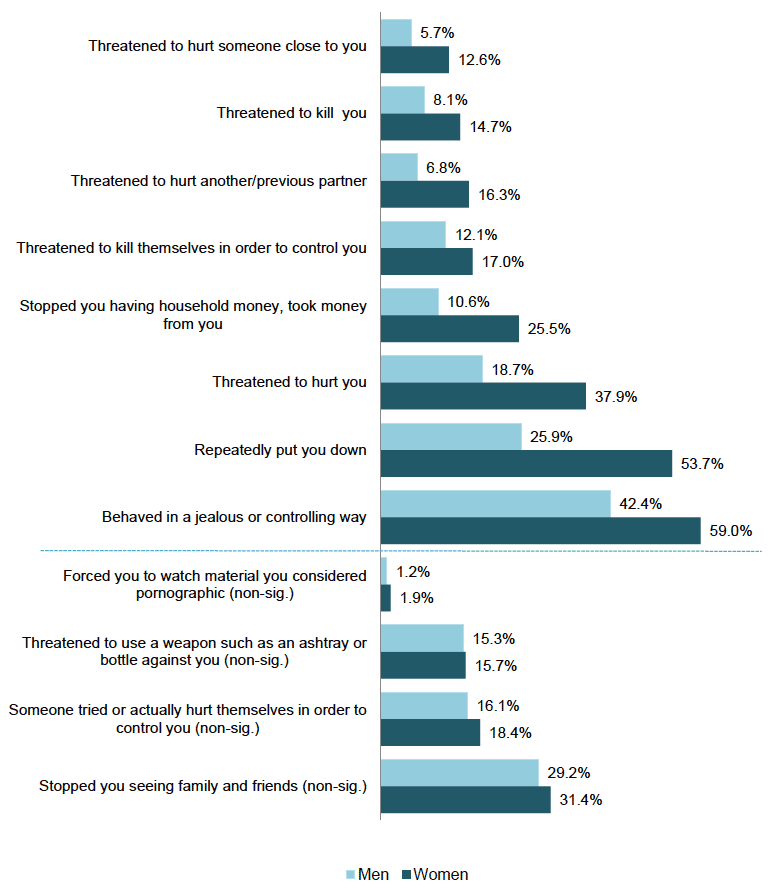
Non-significant differences between men and women are denoted 'non-sig.'
Base: All experiencing at least one type of partner abuse since age 16: men (393) women (1,034)
Variable names: DA_1i_ QDGEN DA_ANYEV
3.3.2 Physical abuse
Again, looking at those who had experienced partner abuse since the age of 16, on average, victims had experienced two different types of physical abuse. A higher proportion of women than men had experienced four different types of physical abuse. These were: being pushed or held down; being choked, strangled or smothered; forced intercourse, and other forced sexual activities.
In one category (having something thrown at you), the proportion of men was higher than the proportion of women (40.1% men, compared to 30.7% women. In two categories, the gender difference was not statistically significant. These were having a weapon (such as an ashtray or bottle) used against you, and being kicked, bitten or hit. Figure 3.2 shows the results.
Figure 3.2 Types of physical abuse since age 16, by gender (%)
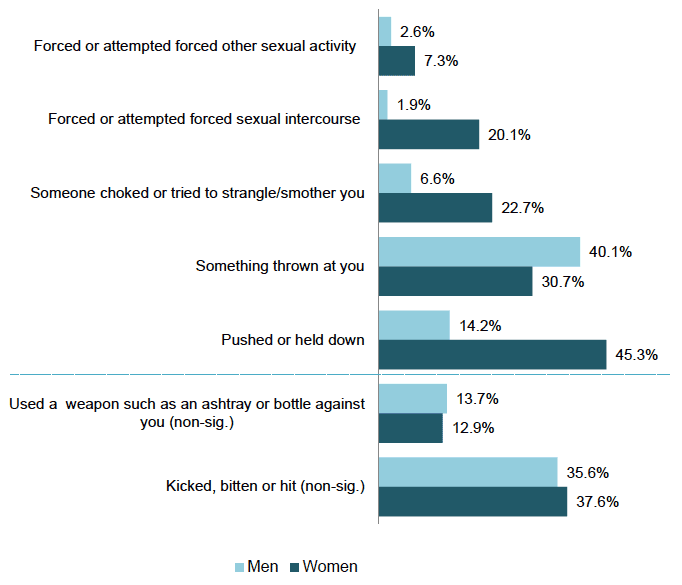
Non-significant differences between men and women are denoted 'non-sig.'
Base: All experiencing at least one type of partner abuse since age 16: (men (393) women (1,034)
Variable name: DA_1iii
The findings in Figure 3.2 suggest that the act of physically striking someone (with or without a weapon) is common to both sexes. However, women are likely than men to experience contact-based forms of restraint and abuse, such as pushing, choking and sexual violence; whereas men are more likely than women to experience non-contact forms of violence, such as throwing objects. These are qualitatively different forms of violence, and point towards a greater severity of violence against female victims than men.
3.4 Relationships and children
Respondents who had experienced partner abuse since the age of 16 and in the las t 12 months were asked about their relationships with the abusive partner/s.
Of those who had experienced at least one incident of partner abuse since the age of 16 ( n = 1,427), nearly three quarters (71.0%) reported having only one abusive partner. A further 13.0% reported that they had two abusive partners since they were 16, and 9.0% reported having had three or more abusive partners. The remaining respondents either did not wish to answer (5.0%) or did not know (2.0%).
Looking at respondents who had experienced partner abuse within the last 12 months ( n = 238), a third (33.5%) said that they were living with the abusive partner at the time of the most recent incident. The most common type of relationship arrangement (at the time of the most recent incident) was living together as a couple (31.7%), followed by marriage (23.3%). More than a quarter (29.0%) stated that they did not want to answer this question.
Nearly half (48.3%) of those who had experienced at least one incident of partner abuse in the last 12 months and were living with the responsible partner at that time, said that they were still living with the abusive partner at the time of the survey.
3.4.1 Gender and sexual orientation
Respondents were asked to state the gender of any abusive partners. Of those who had experienced partner abuse since the age of 16, 68.8% said the abuser was male, and 27.7% said the abuser was female. Less than one per cent stated that both male and female partners had perpetuated abuse.
Breaking this down by the gender of respondents, Figure 3.3 show that abusive partners were overwhelmingly of the opposite gender. That said, however, male respondents were more likely to be victims of a male perpetrator than women were to be victims of a female perpetrator.
Figure 3.3 Gender of abusive partners, by gender of respondent (%)
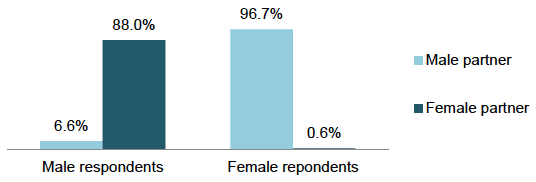
Base: All experiencing partner abuse since age 16 (men 393, women, 1,034).
Variable names: DA_1vi QDGEN
3.4.2 Presence of children
Respondents who reported at least one incident of partner abuse in the last 12 months were asked whether any children were living with them at time of the most recent incident and, if so, whether the children were present during the incident or involved in any way.
More than a third (39.4%) of those who had reported at least one incident of partner abuse in the last 12 months ( n = 238) said that children were living in the household when the most recent incident took place.
As might be expected (given the age-distribution of child-bearing), the presence of children varied by the age of respondents. Those aged 35 to 44 were most likely to report that children lived in the house at the time of the most recent incident (59.3%), compared to 26.3% in the youngest age bracket (16 to 24 years), and 20.1% in the oldest age bracket (65 or over). It is important to note, however, that some groups have small base sizes, particularly amongst those aged 65 or over. Figure 3.4 shows the results.
Figure 3.4 Whether children were living in the household when most recent abuse took place, by age-group (%)
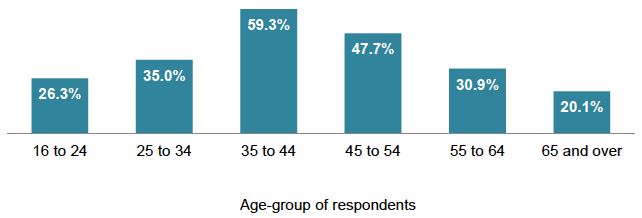
Bases. All experiencing at least one type of partner abuse in 12 months: 16-24 (27) 25-34 (58) 35-44 (54) 45-54 (55) 65 and over (12)
Variable names: DA_2, QDAGE
3.4.3 The impact of partner abuse on children
Of those who reported partner abuse in the last 12 months and said that there were children living in the house ( n = 94), nearly two thirds (63.7%) said that the children were present (in or around the house or close by) during the most recent incident.
Amongst these respondents ( n = 65), three quarters (75.3%) said that the children saw or heard what happened. Within this group of respondents ( n = 46), nearly a fifth (18.8%) said that children had become involved in the incident, and just over a quarter (26.0%) said that the children experienced emotional or psychological effects (such as difficulty sleeping, low self esteem, anxiety) as a result. Whilst the low base numbers mean that these results should be treated with caution, they are generally consistent with a wider body of evidence on the impact of domestic abuse and children (see Box 3.1).
Box 3.1 The impact of partner abuse on children
Partner abuse can impact on children and young people, both directly or indirectly. A study by Mullender at al (2000) found that the most common response amongst children was fear, which often persisted after the abuser had left, and led to sleeping difficulties and nightmares. Holden (2003) observed that children were likely to be intimidated by abusers, and face abuse themselves. There is also an established link between domestic abuse and physical abuse of children (World Health Organisation, 2002).
Evidence suggests that boys exposed to partner abuse committed by men may learn a model of abusive, misogynistic behaviour that they imitate in later life. For example, a number of studies have drawn links between witnessing domestic abuse as a child, and partner violence perpetuated by adult males (Saunders 1993, Holtzworth-Munroe et al 1997, Riggs et al 2000, Jewkes 2002.
In Scotland, an evaluation of the IVY (Interventions for Vulnerable Youth) project (Moodie and Anderson, 2015) found that exposure to violence in the home was a high risk factor for predicting violence amongst young people. Seventy six per cent of those referred to the IVY project had witnessed domestic violence in the home, and 28 out of the 42 young people assessed as part of the project had been exposed to violence in the home.
The next part of the report presents evidence on children and abuse from the longitudinal Growing Up in Scotland study. The data provide further important insights into the impact of partner abuse on children and families, and are published here for the first time.
3.5 Growing Up in Scotland study and partner abuse
The Growing Up in Scotland Study ( GUS) is a large-scale, longitudinal study of two representative cohorts of children, born in 2004/05 and 2010/11 and living in Scotland. Most data is collected from the child's main carer, usually the child's mother, through interviews conducted in the family home on an annual or biennial basis.
In 2010/11, in a self-completion section of the questionnaire, the main carers of children in the older cohort - Birth Cohort 1- - were asked about their experiences of partner abuse over the previous six year (since the birth of the cohort child). Carers were asked about a range of abusive behaviours, which broadly overlap with those asked about in the SCJS, [16] however for the GUS analysis they are classified differently, into physical, controlling and threatening abuse as follows:
Physical abuse:
- Pushed you or held you down
- Kicked, bitten or hit you
- Choked or tried to strangle/smother you
- Used a weapon against you ( e.g. an ashtray or a bottle)
- Forced you or tried to force you to take part in any sexual activity when you did not want to
Controlling abuse:
- Stopped you having a fair share of household money or took money from you
- Repeatedly put you down so that you felt worthless
- Behaved in a jealous or controlling way ( e.g. restricting what you can do, who you can see, what you can wear)
Threatening abuse:
- Threatened to hurt you
- Threatened to hurt someone close to you ( e.g. your children, friends, pets)
- Threatened to, attempted to, or actually hurt themselves as a way of making you do something or stopping you from doing something
- Threatened you with a weapon ( e.g. an ashtray or a bottle)
- Threatened to kill you
Whilst the study does not provide trend data on partner abuse, or nationally representative prevalence rates, it can provide reliable data on the proportion of 6-year old children living with a main carer who had experienced partner since their (the child's) birth. The study also benefits from the long-term involvement of respondents [17] . This means that respondents may have been more comfortable answering personal questions, compared to those involved in one-off studies.
The findings presented in this part of the report are based on weighted responses from 3,553 respondents. To ensure consistency, the analysis is restricted to mothers (including adoptive, foster and step mothers). The GUS study is not a National Statistics product.
These questions were put to GUS participants in 2010/11. As Chapter 2 showed, the overall risk of experiencing partner abuse has decreased between 2010/11 and 2014/15 (see Table 2.1). This means that the current proportion of 6 year olds living with a main carer who experienced partner abuse may be smaller than estimated in this section.
3.5.1 GUS prevalence and frequency of partner abuse
In 2010/11, 14% of 6-year old children were living with a main carer who had experienced partner abuse since the child's birth. Looking at the categories of abuse experienced in this period, 11% of 6-year olds were living with a main carer who had experienced controlling abuse, 7% with a main carer who had experienced physical abuse and 6% with a main carer who had experienced threatening abuse. Some children (4%) were living with a main carer who had experienced all three forms of partner abuse since their birth, 3% with a main carer who had experienced two forms and 7% with a main carer who had experienced one form of partner abuse.
Over half (56%) of the main carers who had experienced partner abuse by the time their child reached his/her 6 th birthday stated that they had experienced abuse more than once, and 15% had experienced abuse 'too many times' to count'. Table 3.1 shows the results.
Table 3.1 GUS frequency of partner abuse, among main carers of children aged 6 who had experienced any form of partner abuse since the birth of the child (%)
| Frequency of any type of GUS partner abuse | % |
|---|---|
| One time | 18% |
| Two or three times | 25% |
| Four or five times | 10% |
| Six or more times | 6% |
| Too many to count | 15% |
| Don't know/ can't remember | 14% |
| Don't wish to answer | 11% |
| Unweighted Base | 422 |
3.5.2 GUS circumstances of mothers and partner abuse
Consistent with the demographics of SCJS partner abuse shown in Section 2.5.4, the findings from GUS show that the prevalence of partner abuse amongst mothers was higher amongst mothers from the most deprived areas of Scotland, and in the lowest income bracket (quintile). The prevalence of partner abuse amongst mothers was also higher amongst those with lower levels of educational attainment, Tables 3.2 to 3.6 show the results.
Note that the results in this section are based on the circumstances of mothers when their child was aged 10 months old ( GUS asks about abuse within a 6-year period, and cannot identify circumstances at the exact time of abuse).
Table 3.2 GUS prevalence of partner abuse (by child's 6th birthday) by neighbourhood deprivation (around the time of child's birth) (%)
| Type of abuse | Scottish Index of Multiple Deprivation- quintile | ||||
|---|---|---|---|---|---|
| Most deprived | 2nd | 3rd | 4th | Least deprived | |
| Controlling abuse | 15% | 13% | 10% | 8% | 6% |
| Physical abuse | 10% | 9% | 6% | 6% | 4% |
| Threatening abuse | 8% | 7% | 6% | 5% | 3% |
| Any form of partner abuse | 18% | 17% | 12% | 11% | 9% |
| Unweighted Base | 563 | 547 | 717 | 714 | 721 |
Table 3.3 GUS prevalence of partner abuse (by child's 6th birthday) by household income (around the time of child's birth) (%)
| Type of abuse | Equivalised household income - quintile | ||||
|---|---|---|---|---|---|
| Bottom | 2nd | 3 rd | 4th | Top | |
| Controlling abuse | 21% | 12% | 9% | 6% | 4% |
| Physical abuse | 15% | 9% | 5% | 4% | 3% |
| Threatening abuse | 13% | 6% | 5% | 3% | 2% |
| Any form of partner abuse | 24% | 16% | 12% | 8% | 7% |
| Unweighted Base | 419 | 566 | 589 | 732 | 672 |
Table 3.4 GUS prevalence of partner abuse (by child's 6 th birthday) by mother's level of education (around the time of child's birth) (%)
| Type of abuse | Mother's education | ||||
|---|---|---|---|---|---|
| No qualifications | Lower level Standard Grades and Vocational qualifications | Upper level Standard Grades + Intermediate Vocational qualifications | Higher Grades and Upper level Vocational qualifications | Degree level academic and vocational qualifications | |
| Controlling abuse | 15% | 14% | 13% | 10% | 7% |
| Physical abuse | 8% | 10% | 10% | 7% | 4% |
| Threatening abuse | 8% | 8% | 8% | 6% | 3% |
| Any form of partner abuse | 18% | 16% | 17% | 13% | 9% |
| Unweighted Base | 190 | 169 | 764 | 1,107 | 1,030 |
Table 3.5 below shows that the prevalence of partner abuse fell as the mother's age increased: 30% of mothers aged under 20 at the time of the child's birth had experienced partner abuse, falling to 10% among those aged 40 or over.
Table 3.5 GUS prevalence of partner abuse (by child's 6th birthday) by age of mother at time of child's birth (%)
| Type of abuse | Mother's age (at time of child's birth) | ||||
|---|---|---|---|---|---|
| Under 20 | 20-29 | 30-39 | 40 and over | ||
| Controlling abuse | 24% | 13% | 7% | 7% | |
| Physical abuse | 21% | 8% | 4% | 5% | |
| Threatening abuse | 18% | 7% | 3% | 2% | |
| Any form of partner abuse | 30% | 16% | 9% | 10% | |
| Unweighted Base | 130 | 1,152 | 1,852 | 124 | |
3.5.3 Growing Up in Scotland Study: Conclusions
The fact that 14% of 6 year olds were living with a main carer who experienced some form of partner abuse suggests that such abuse affects the lives of many children. Future GUS analysis is likely to explore the impact that having a main carer who experienced partner abuse has on longer-term outcomes for children.
The evidence has confirmed a link between the experience of partner abuse and socio-economic disadvantage. While socio-economic disadvantage could be a causal factor in the abuse it is also possible that it was a result of having left an abusive partner. The GUS evidence also shows, for the first time, the extent to which young mothers are at a particularly high risk of partner abuse.
3.6 Impact of partner abuse
SCJS respondents who reported at least one incident of partner abuse within the last 12 months ( n=238) were asked about the impact of the most recent (or only) incident.
Respondents were asked about a range of impacts or effects, which can be broadly categorised as either psychological or physical in nature. A higher proportion of respondents reported at least one psychological effect (65.2%), compared to those who reported at least one physical effect (39.6%).
Box 3.2 Partner abuse and homelessness
The SCJS sample does not include homeless populations, or those living in residential settings such as hostels. However, a study of homeless women by Shelter found that domestic abuse was the single most quoted reason for becoming homeless, cited by 40% of respondents (Women's Aid, 2013).
3.6.1 Psychological impact
As noted previously, of those who had experienced partner abuse in the last 12 months, 65.2% reported at least one psychological effect. The most common impact was low self-esteem, which was reported by 37.4% of all victims. A higher proportion of women than men experienced low self-esteem, at 44.5% and 27.2% respectively.
Overall, women were more likely to report psychological effects than men. Looking at the psychological impact amongst those who reported partner abuse in the last 12 months, 74.4% of women reported at least one psychological effect, compared to 52.1% of men. Relatedly, 43.5% of men said that they did not experience any of the listed psychological effects, compared to 17.9% of women.
Figure 3.5 below shows that women were more likely than men to report anxiety and panic attacks, difficulty sleeping and depression, fear, low self-esteem, loss of trust and difficulty with relationships, depression, feeling unable to attend work or college, and deliberate self-harm.
In four categories, the gender difference was not statistically significant. These were: doing things that weren't good for me to help me cope; isolation from children; isolation from family or friends; and attempting suicide.
Figure 3.5 Reported psychological effects of most recent/only incident of partner abuse within the last 12 months (%)
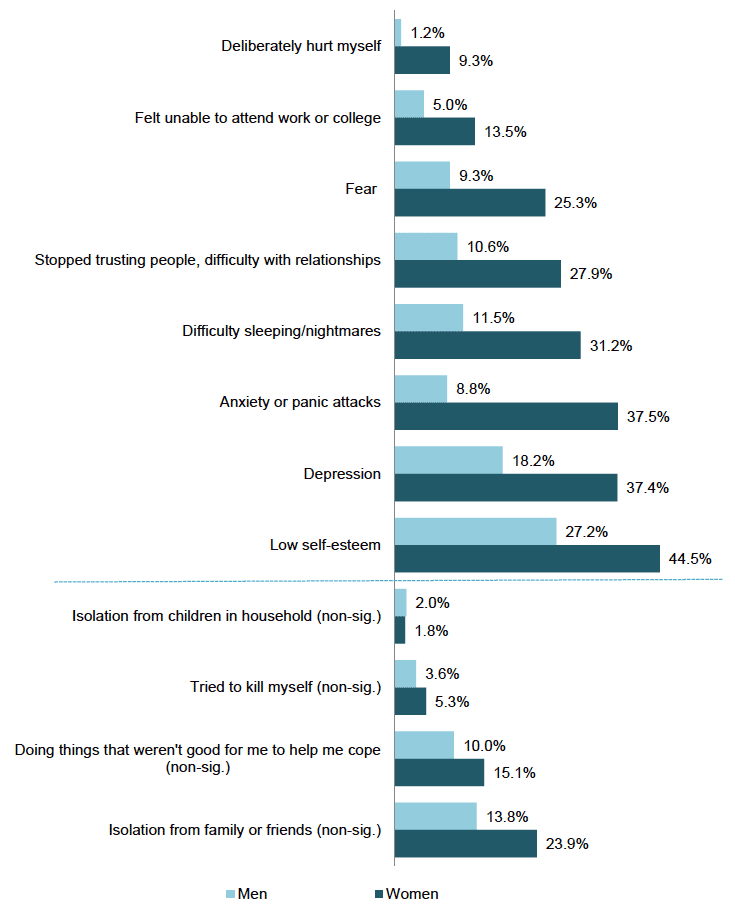
Non-significant differences between men and women are denoted 'non-sig.'
Base: Adults who experienced partner abuse in last 12 months (women 149, men 89).
Variable name: DA_9_13 to DA_9_12, QDGEN
Box 3.3 The impact of psychological abuse
Psychological abuse can have a profound negative effect on mental health. A study by Dutton et al (1999) found that high levels of psychological abuse significantly predicted post traumatic stress disorder and acute stress. A qualitative study by Humphreys and Thiara (2003) reported intense fear amongst victims, an undermined sense of self, high levels of trauma-related stress and alcohol dependency, by way of coping.
3.6.2 Physical impact
Of those who had experienced partner abuse in the last 12 months ( n = 238), 39.6% reported at least one physical effect. The most common physical effects were: minor bruising or black eyes (21.6%); scratches or minor cuts (15.2%); and severe bruising (8.5%). A further 8.5% said that they did not wish to answer the question. Unlike the psychological impacts in Figure 3.5, there were no significant differences between men and women in the physical impacts.
3.6.3 Cumulative effect of partner abuse
To recap, Section 3.4 showed that of those who had experienced partner abuse in the last 12 months ( n = 238), 65.2% reported at least one psychological effect, and 39.6% reported at least one physical effect.
Breaking these results down further indicates that the cumulative impact of partner abuse is more likely to be psychological in nature. A quarter (24.6%) experienced only one psychological effect. A further 40.5% experienced more than one effect, with 12.2% experiencing two effects, 6.4% experiencing three effects, and 21.9% experiencing four or more effects. Just over a quarter (28.5%) had experienced none of the listed psychological effects, and 6.3% did not want to answer.
A lower proportion experienced multiple physical effects. Again, looking at those who had experienced partner abuse in the last 12 months, just over a quarter (27.8%) reported only one physical effect. A further 11.8% experienced more than one effect, with 6.6% experiencing two effects, 2.7% experiencing three effects and 2.5% experiencing four or more effects. Just over half (51.9%) experienced none of the listed physical effects and 8.5% did not want to answer.
3.6.4 Cumulative abuse and gender
The cumulative impact of psychological abuse varied by gender. Whilst a similar proportion of women and men reported one psychological effect (22.9% women and 25.7% men), a higher proportion of women than men reported four or more psychological effects, at 31.1% and 8.8% respectively.
By contrast, the cumulative impact of physical abuse did not vary by gender. Note that more advanced statistical analysis is required to gauge the cumulative impact of both physical and psychological abuse. Table 3.6 shows the results.
Table 3.6 Count of psychological and physical effects of partner abuse in the last 12 months, by gender (%)
| Number of effects reported | Psychological | Physical | ||
|---|---|---|---|---|
| % men | % women | % men | % women | |
| One | 22.9% | 25.7% | 35.9% | 22.1% |
| Two | 14.4% | 10.7% | 7.2% | 6.2% |
| Three | 5.9% | 6.7% | 0.0% | 4.6% |
| Four or more | 8.8% | 31.1% | 2.0% | 2.9% |
| Did not want to answer | 4.3% | 7.7% | 6.6% | 9.8% |
| None of the listed effects | 43.5% | 17.9% | 48.3% | 54.5% |
Base: All who experienced partner abuse in last 12 months (women 149, men 89).
Variable names: DA_9 DA_8 QDGEN
3.7 Perceptions of partner abuse
Respondents who had experienced partner abuse in the last 12 months were asked if they viewed the abuse as a crime. Separately, respondents who had experienced partner abuse since the age of 16 were asked if they considered themselves to be a victim of domestic abuse.
The term 'domestic abuse' is not introduced to respondents until the final question in the self-completion module, and is not predefined for respondents. Rather, the aim is to capture respondents' own understandings of abuse.
3.7.1 Perception of partner abuse and crime
Overall, respondents were more likely to view physical abuse as a crime, compared to psychological abuse. Nearly a third (32.5%) regarded their experiences of physical abuse (in the last 12 months) as a crime, whereas less than a fifth (17.9%) regarded their experiences of psychological abuse as a crime.
Respondent's perceptions of partner abuse and crime also varied by gender. In general, women viewed their experiences of abuse more critically, compared to men. Half of women (50.0%) viewed their experiences of physical abuse as a crime, compared to 12.0% of men. Similarly, a higher proportion of women than men viewed their experiences of psychological abuse as a crime, at 25.9% and 5.1% respectively. Meanwhile, a higher proportion of men than women described their experiences of physical abuse as 'wrong, but not a crime', at 43.7% and 23.1% respectively.
A higher proportion of men than women appeared uncertain as to how to interpret their experiences of partner abuse. For example, 17.1% of male victims said that they were not sure if their experience/s of physical abuse were a crime, compared to 4.5% of women. Similarly, 20.0% of men said they were not sure if their experience/s of psychological abuse were a crime, compared to 4.4% of women. Figure 3.6 presents the results.
Figure 3.6 Victims perceptions of physical and psychological partner abuse in the last 12 months, by gender (%)
Physical abuse
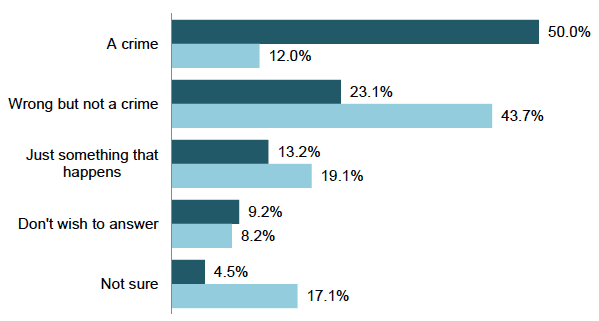
Base: All who experienced physical abuse in last 12 months: men (51) women (81)
Variable names: DA_19 QDGEN
Psychological abuse
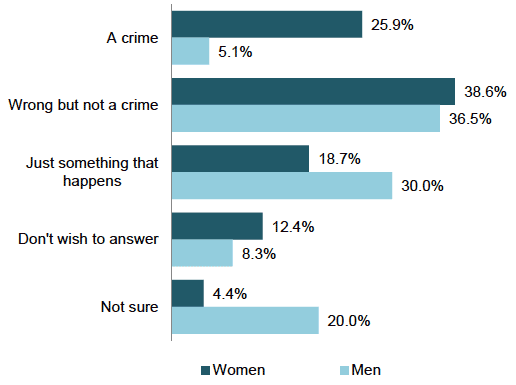
Base: All who experienced psychological abuse in last 12 months: men (71) women (132)
Variable names: DA_19, DA_18, QDGEN
3.7.2 Perceptions of victimization
Overall, 7.9% of all respondents ( n = 9,312) considered themselves to have been a victim of 'domestic abuse' since the age of 16, lower than the proportion that had experienced at least one incident of SCJS partner abuse in the same time-period (14.1%).
Breaking these results down by gender, the proportion of women who felt they had been a victim of domestic abuse since the age of 16 (12.3%) was lower than the proportion that had experienced at least one incident of partner abuse in the same time-period (18.5%).
However, this disparity was more pronounced for men, with only 2.9% of men considering themselves to have been a victim of domestic abuse since the age of 16, while 9.2% had reported at least one incident of SCJS partner abuse in the same period.
Looking at those who had experienced at least one type of SCJS partner abuse since the age of 16, less than half (46.3%) viewed themselves as a victim of domestic abuse. Again, a higher proportion of women than men viewed themselves as victims of domestic abuse, at 56.9% and 22.9% respectively.
Of those who defined themselves as having been a victim of domestic abuse, 16.9% did not report any incidents in the survey. The reasons for this disparity are out-with the scope of this report, although it could result from the respondent's interpretation of the term. For example, domestic abuse could apply to a range of different experiences and scenarios, including abuse by family members other than partners. There may also be an overlap with the questions on stalking, harassment and sexual victimisation (which are asked in a different section of the self-completion questionnaire). It is also possible that respondents did not want to recount their experiences.
Overall, the findings in this section suggest that the way in which people interpret their experiences of partner abuse are complex. The gap between respondents' experiences and perceptions of partner abuse may also tap into different histories of abuse (cumulative, multiple), and/or reflect wider societal attitudes towards partner abuse. Box 3.4 summarizes findings on public attitudes towards partner abuse (Reid et al., 2015) from the Scottish Social Attitudes Survey ( SSA) 2014. [18] These results suggest that people's attitudes tap into ideas about victim culpability and mitigating circumstances, and are likely to vary by demographic characteristics, including age and gender.
Box 3.4 Public attitudes to partner abuse
The Scottish Social Attitudes Survey, 2014 found that over 9 in 10 people thought that physical abuse of a partner was seriously wrong, regardless of whether the perpetrator and victim was male or female.
When asked about a hypothetical scenario in which the husband has found out his wife had had an affair, attitudes were less critical towards the husband. In this scenario, around half (54%) thought that the man's behaviour was 'very seriously wrong'. Older people and those with stereotyped views on gender roles were less likely to think that the man slapping his wife after she has had an affair was seriously wrong and caused her harm, and more likely to think that the wife should forgive her husband.
Abuse perpetuated by men appeared to be viewed more critically than abuse perpetuated by women. For example, a higher proportion felt it was 'very seriously wrong' for a man to get angry and slap his wife (92%), compared to a wife slapping her husband (81%). Similarly, 94% said it was seriously wrong when a man criticised his wife, whereas 88% thought it was seriously wrong when a woman criticised her husband. Fifty per cent thought that a husband trying to stop his wife going out with friends was 'very seriously wrong', compared to 23% who thought this if a wife was trying to stop her husband going out.
Attitudes also varied by demographic characteristics. Women were more likely to feel that a man criticising his wife was wrong (77% women, compared with 68% men), as were those in the highest income group, compared to the lowest income group (77% compared with 64%). Those with higher levels of formal education were also more likely to think that a husband trying to stop his wife going out was 'very seriously wrong'. Younger people, those on higher incomes and those who did not hold stereotypical views on gender roles were all more likely to think that a woman criticising her husband was 'very seriously wrong'. Women were also more likely than men to see controlling behaviour as wrong, irrespective of the gender of the victim. Older people were more likely to think that financially controlling behaviour was wrong and harmful; 40% of those aged 65 or over thought it would cause 'a great deal of harm' compared with only 26% of those aged 18 to 29 years old.
A smaller proportion (39%) believed it was 'very seriously wrong' for a man to tell his wife to change her clothes before going on a night out. Asked about a scenario in which the wife had had an affair, a smaller proportion said that a husband telling his wife to change her clothes before going out was wrong. This suggests that certain circumstances are seen to excuse the behaviour and mitigate its seriousness.
Contact
There is a problem
Thanks for your feedback